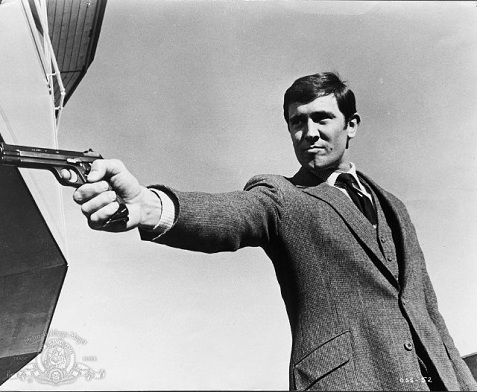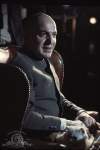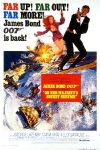007 One by One: On Her Majesty’s Secret Service
Bullz-Eye continues its look back at every James Bond film, 007 One by One, as part of our James Bond Fan Hub that we’ve created to celebrate the 50th anniversary of the first Bond film.
You’ve seen “Skyfall,” now how about taking a look at the other best James Bond movie you’ve never seen?
Ask a hardcore Bond aficionado what his favorite 007 entry is, and there’s a very good chance the answer will be “On Her Majesty’s Secret Service.”
We don’t necessarily want to make bold claims as to what the best Bond movie is, as it differs from person to person, but “Majesty’s” should be Top Five material for any die-hard fan of the franchise. The film is littered with all kinds of “firsts” and “onlys” — both in front of and behind the camera — but the most obvious is of course its lead, George Lazenby, and it’s with Lazenby that, for better or worse, most talk of the film begins (but should by no means end).
In the year 2013, we take for granted the changing of the lead actor within the Bond series, as we’ve now had a half a dozen different 007s, but back in the late sixties there was only one James Bond, and his name was Sean Connery. During the production of “You Only Live Twice,” Connery decided to exit the franchise that made him a household name (though as we now know today, he’d return to the character not once, but twice), however, quite understandably, the producers of the series weren’t finished telling their stories, and the public seemed far from tired of 007’s adventures.
So there was really only one option and that was to recast. The search was extensive, but in the end Bond producers decided on a complete unknown – Lazenby – a model with virtually zero acting experience. Regardless, Albert Broccoli was certain he could transform the man into his new James Bond.
The debate has raged for over 40 years as to whether or not the recasting was successful, with many schools of thought on the matter. Having viewed “Majesty’s” numerous times, we feel confident in saying that it’s a shame Lazenby didn’t give it at least one more go in the part (the decision to not return was, amazingly, his own), because as it stands, he cannot help but be somewhat swallowed up by the richness of his surroundings. One thing is for certain: Lazenby in no way ruins it, or keeps “Majesty’s” from being the best film it can be. “On Her Majesty’s Secret Service” is a fine, fine movie, and one that deserves to stand on its own, away from the greater picture of the whole franchise, and Lazenby – as any lead would be – is at least partly responsible for its artistic success.
The Plot: “On Her Majesty’s Secret Service” relies heavily on Ian Fleming’s original text, the last Bond film to really do so until 2006’s “Casino Royale.” The story is two in one: the first is about Bond’s hunting for and eventual finding of Ernst Stavro Blofeld, and the second is about Bond falling in love and getting married (yes, you read that right) to an initially suicidal young woman named Tracy. Her father, Draco, runs a crime syndicate, and has info about Blofeld’s whereabouts, which James requires. Turns out Blofeld is posing as a high-profile allergist in Switzerland. Bond tracks him there, and infiltrates his organization by posing as a genealogist. Once the jig is up, all hell breaks loose, and Bond finds himself on the run, and only one person can help him…
The Girls: Blofeld’s mountaintop Swiss hideaway, Piz Gloria, stockpiles quite the cache of babe-alicious flesh – including a very young Joanna Lumley (“Absolutely Fabulous”) as well as the lovely Catherine Schell (“The Return of the Pink Panther”). Odd then that James zeroes in on the homeliest looking one of the bunch, Ruby Bartlett (Angela Scoular). But then again, this is also that unique Bond flick wherein James falls in love, and perhaps going for runt of the litter was the only way for him to rationalize cheating on his beloved Tracy.
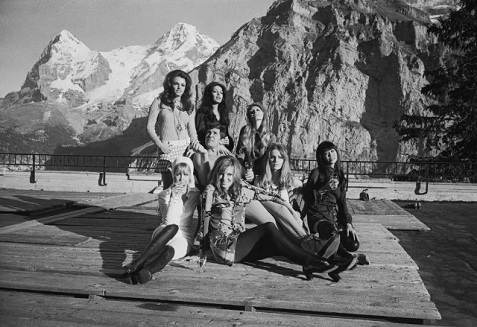
Yes, the only real Bond girl in “Majesty’s” is Contessa Teresa di Vicenzo –Tracy for short — played by Emma Peel herself, Diana Rigg. If James Bond is going to fall in love, it had damn well better be someone like Diana Rigg. One can picture producers Cubby Broccoli and Harry Saltzman sitting around saying variations on, “We need to get someone like Diana Rigg for the part”…until finally realizing they’d better just get Diana Rigg. Tracy steals Bond’s heart in the film’s first 45 minutes and then disappears for the next hour, only to come out of nowhere and heroically rescues James from his predicament high up in the Swiss Alps, at which point he realizes that she’s “the one.” When she finally “Peels” out, it’s the moment every “Avengers” fan has waited for the entire film. [SPOILER ALERT] And when she’s murdered moments after trading “I do’s” with 007, it’s heartbreaking to see James cradle her lifeless body in his arms. One wonders what kind of shock this must have been for fans back in 1969.
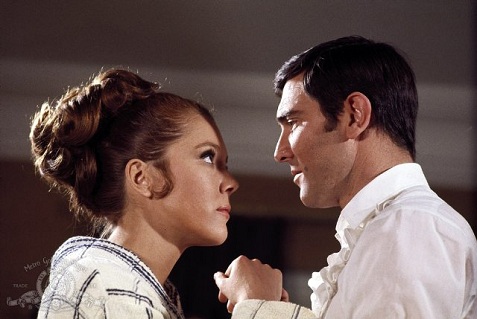
The Nemeses: Of the three major Blofelds to appear onscreen in the official franchise, Telly Savalas (like the rest of the movie) is often forgotten. He’s also the only one of the three to deliver a remotely realistic performance, which may be part of the reason he doesn’t resonate in the public consciousness. We like our villains larger than life, do we not? His look is not as iconic as Donald Pleasance, nor is his portrayal as camp as Charles Gray. Yet what he brings to Ernst is cold and calculating — the true essence of villainy. His plan is not to blow up the world, but to hypnotize his 12 patients into releasing a bacterial agent into the world’s agricultural supply unless he’s given amnesty for his past crimes. This makes something of a nice change from holding the world hostage for one-meellion dollars.
Blofeld’s biggest blunder here is his initial inability to recognize Bond. Yes, Bond has a new face — but Bond recognizes Blofeld, even though he too has a new face. Neither is supposed to have a new face within the storyline itself, though it’s stated that Blofeld has had some minor plastic surgery done to his earlobes (of all things). The conundrum is actually a result of adhering so closely to the original novel, which preceded the novel of “You Only Live Twice” – an order which was flipped in the film series. Come “Diamonds are Forever,” the whole “getting a new face” thing is weaved into the plot, yet they can both recognize one another, despite one having a new face and the other having gone back to his old face.
Blofeld isn’t the movie’s only villain. His henchwoman, Irma Bunt (Ilse Steppat), is a nasty piece of work, and possibly a thinly veiled lesbian caricature, though that assertion could and should be debated. She owes a lot to Lotte Lenya’s Rosa Klebb in “From Russia with Love,” but lacks her jolly sense of humor. And she pulls the trigger that kills Tracy. What a bitch.

The Gadgets: It was a conscious move on the part of director Peter R. Hunt to move away from the gadgets in this film, so they are few. Early in the picture Q shows off to M something he calls radioactive lint, but it’s never used as part of the plot. The only real gadget Bond uses in this film is a cumbersome dual safecracker/photocopier. The former aspect of the gimmick remains cool even today. While the latter is extremely mundane by today’s standards, the fact that it’s packaged with a safecracker keeps it vaguely cool.
The Cars: The Aston Martin DBS – different than the iconic DB5 from “Goldfinger” – features as Bond’s new car in this movie. Tracy’s ride, a red Mercury Cougar XR7 Convertible, sees far more action in the movie than Bond’s Aston Martin, by playing a big part on the film’s third act. Blofeld’s henchmen chase Bond and Tracy in a Mercedes 220S, while their boss, alongside Irma Bunt, drives a silver Mercedes-Benz 600 in the final moments of the film. Draco drives a 1968 Rolls Royce Silver Shadow Convertible.
The Music: Since “On Her Majesty’s Secret Service” was quite the mouthful, John Barry opted to compose an instrumental piece for the opening credits, and it’s a rousing bit of work. More famous than the title tune, however, is “We Have All the Time in the World,” sung by Louis Armstrong, and written by Barry with Hal David behind the lyrics. This little ditty, which plays over several scenes, may as well be called “James and Tracy’s Love Theme.” It would be the last piece of music Armstrong recorded, as he passed on soon afterwards, and it has gone on to have quite the life outside of the Bond film series, including as a popular choice of song to play at weddings (presumably only by couples who have not seen this film).
Final Musings: “On Her Majesty’s Secret Service” isn’t perfect, and in fact has one major flaw: For the lengthy stretch in which Bond infiltrates Blofeld’s lair, pretending to be Sir Hilary Bray, the decision was made to dub Lazenby’s voice with George Baker’s (the actor who played Bray earlier in the movie). We’ll never know what voice Lazenby used for all those scenes (Bond is, in fact, at his most talkative for this section of the movie), so we must assume that it was felt to not be up to par. The dubbing is painfully obvious, though if you’re as big a fan of this movie as we are, you’ll learn to overlook it.
Beyond that most bizarre of artistic decisions, the rest is about as ideal as a Bond movie can be. The cinematography from Michael Reed is exceptional and the direction from Peter Hunt precise. Much of the film takes place in the wintry world of Switzerland, and you’ll not find snow and ski scenes that are done this well in any other Bond picture. The final hour is packed with one inventive action sequence after another, culminating in an avalanche which swallows up Bond and his bride to be. Even later, Bond goes after Blofeld in an intense bobsled chase.
Then there’s the tragic love story, which itself makes the movie a unique, important entry in the James Bond series – a helpful key to understanding the central character (there would be numerous references to Bond’s ill-fated marriage in later films). Further, its story is imperative to the ongoing tale of Bond vs. Blofeld that was carefully woven throughout the ‘60s. “On Her Majesty’s Secret Service” is one for the books. This isn’t your manly Connery of the ‘60s, your wisecracking Moore of the ‘70s & ‘80s, or your paint-by-numbers Brosnan of the ‘90s. The film almost exists in its own near-perfect little bubble, though from an emotional standpoint, it’s precisely the sort of fare the Daniel Craig movies are made of today, 40 some-odd years after its creation.
Stray Bullets:
The Bond family motto is revealed here to be “The World Is Not Enough,” which would years later be used as the title of Pierce Brosnan’s third James Bond outing.
The only movie in which Bond wears a kilt.
Bond doesn’t just read, but practically studies an issue of Playboy in one scene, including the centerfold.
Brigitte Bardot was the actress the Bond producers originally wanted for the part of Tracy.
In an effort to stress to viewers that these were the continuing adventures of the same man, the title sequence largely consists of a montage of clips from the previous Bond films.
In one scene, a midget janitor whistles the theme to “Goldfinger.”
Early in the film, during a sequence in which Bond threatens to resign from his job, we, for the first and currently only time in the series, sees Bond’s office. He roots through his desk, sifting through various bits of nostalgia from all the previous Bond movies.
The first film in which Bond skis.
The only Bond film directed by Peter Hunt, who’d worked on all the previous Bond films in various capacities. Unfortunately, he never worked on another Bond film after this one, in any capacity.
You can follow us on Twitter and Facebook for content updates. Also, sign up for our email list for weekly updates and check us out on Google+ as well.
Posted in: Entertainment, Lifestyle, Movies
Tags: 007, 007 50th anniversary, 007 films, 007 movies, 007 One by One, 007 villains, Albert Broccoli, Angela Scoular, Aston Martin DBS, beautiful Bond women, best Bond movie moments, best James Bond babes, Blofeld, Bond babes, Bond films, Bond girls, Bond movies, Bond one by one, Bond villains, Catherine Schell, Contessa Teresa di Vicenzo, Cubby Broccoli, Diana Rigg, George Lazenby, Harry Saltzman, Ian Fleming, iconic Bond girls, iconic James Bond babes, iconic James Bond moments, Ilse Steppat, Irma Bunt, James and Tracy’s Love Theme, James Bond, James Bond 007, James Bond 50th anniversary, James Bond actresses, James Bond babes, James Bond blog, James Bond cars, James Bond craze, James Bond franchise, James Bond girls, James Bond henchmen, James Bond marriage, James Bond movies, James Bond music, James Bond nemesis, James Bond villains, Joanna Lumley, John Barry, memorable Bond scenes, Mercury Cougar XR7 Convertible, Michael Reed, On Her Majesty's Secret Service, Piz Gloria, Ruby Bartlett, Sean Connery, supervillains, Telly Savalas




